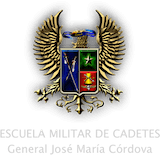Base de datos de la Escuela Militar de Cadetes colombiana 2018
Un estudio sociológico de su población
DOI:
https://doi.org/10.21830/19006586.345Palabras clave:
Base de datos; Ejército Nacional de Colombia; Escuela Militar de Cadetes General José María Córdova; estudios comparativos; sociología militarResumen
Este artículo presenta una base de datos de la población de estudiantes militares, resultado de un estudio sociológico realizado en la Escuela Militar de Cadetes General José María Córdova (ESMIC). Al analizar las percepciones y las actitudes de los estudiantes de la ESMIC en seis áreas, a saber, las características sociodemográficas, comportamiento profesional, patrones sociales, valores militares, relaciones civiles-militares, y la integración de las mujeres en el Ejército, esta base de datos tiene como objetivo proporcionar información científica para ayudar en el diseño, implementación y efectividad de las políticas del Ejército Nacional de Colombia.
Descargas
Referencias bibliográficas
Abrahamsen, R. (2018). Return of the generals? Global militarism in Africa from the Cold War to the present. Security Dialogue, 49(1–2), 19–31. https://doi.org/10.1177/0967010617742243
Angstrom, J. (2013). The changing norms of civil and military and civil-military relations theory. Small Wars & Insurgencies, 24(2), 224–236. https://doi.org/10.1080/09592318.2013.778014
Bitar, S. E., & Gardner. (2016). US Military Bases, Quasi-bases, and Domestic Politics in Latin America. Springer.
Boldry, J., Wood, W., & Kashy, D. A. (2002). Gender Stereotypes and the Evaluation of Men and Women in Military Training. Journal of Social Issues, 57(4), 689–705. https://doi.org/10.1111/0022-4537.00236
Born, H. (2006). Civil-military relations in Europe learning from crisis and institutional change. London; New York: Routledge.
Brænder, M., & Holsting, V. S. (2017). Like attracts like: Military values and branch affiliation of cadets after the reform. Presented at the American Sociological Association Annual Meeting.
Bruneau, T. (2005). Civil-Military Relations in Latin-America: The Hedgehog and the Fox Revisited. Revista Fuerzas Armadas y Sociedad, Año 19(1–2), 111–131.
Bruneau, T., & Matei, F. (2013). The Routledge handbook of civil-military relations. New York: Routledge.
Bruneau, T., & Tollefson, S. (2008). Who Guards the Guardians and How Democratic Civil-military Relations. Austin, Tex.: University of Texas Press.
Caforio, G. (Ed.). (2006a). Handbook of the Sociology of the Military. New York: Springer Science & Business Media.
Caforio, G. (2006b). Social Sciences and the Military: An Interdisciplinary Overview. New York: Routledge.
Caforio, G., & Martinez, R. (2005). The Spanish Cadet in the European Military Context: a Comparative Analysis of the Professional Socialisation (No. 244). Barcelona: Institut de Ciències Polítiques i Socials. Retrieved from http://www.icps.cat/archivos/WorkingPapers/wp244.pdf
Caforio, G., & Nuciari, M. (2018). Conclusion: Themes and Issues of the Sociology of the Military. In Handbook of the Sociology of the Military (pp. 615–650). Springer, Cham. https://doi.org/10.1007/978-3-319-71602-2_31
Cancian, M. F., & Klein, M. W. (2015). Military Officer Quality in the All-Volunteer Force (Working Paper No. 21372). National Bureau of Economic Research. https://doi.org/10.3386/w21372
Chaban, N., Beltyukova, S., & Fox, C. (2018). Communicating NATO in the Asia-Pacific Press: Comparative Analysis of Patterns of NATO’s Visibility, Capability, Evaluation, and Local Resonance. Asian Security, 14(1), 66–81. https://doi.org/10.1080/14799855.2017.1361734
Cimbala, S. (2012). Civil-military relations in perspective strategy, structure and policy. Farnham; Burlington, VT: Ashgate.
Coser, L. A. (2017). The Idea of Social Structure: Papers in Honor of Robert K. Merton. Routledge.
Croissant, A., & Kuehn, D. (2017). Reforming Civil-Military Relations in New Democracies: Democratic Control and Military Effectiveness in Comparative Perspectives. Springer.
Cruz Piñeiro, R., Vargas Valle, E., Hernandez Robles, A. K., & Rodríguez Chávez, Ó. (2017). Adolescentes que estudian y trabajan: factores sociodemográficos y contextuales. Revista Mexicana de Sociología, 79(3), 571–604.
Dahl, G., Kotsadam, A., & Rooth, D.-O. (2018). Does Integration Change Gender Attitudes? The Effect of Randomly Assigning Women to Traditionally Male Teams (Working Paper No. 24351). National Bureau of Economic Research. https://doi.org/10.3386/w24351
Dandeker, C. (2017). A Farewell to Arms? The Military and the Nation-State in a Changing World. The Adaptive Military, 149–172. https://doi.org/10.4324/9781315130835-12
De Pedro, K., Astor, R., Gilreath, T., Benbenishty, R., & Berkowitz, R. (2018). School Climate, Deployment, and Mental Health Among Students in Military-Connected Schools. Youth & Society, 50(1), 93–115. https://doi.org/10.1177/0044118X15592296
De Sousa Almeida, L., Taboada Ares, E. M., Rivas Torres, R. M., Iglesias Souto, P. M., & López Gómez, S. (2017). Rendimiento académico y variables sociodemográficas y académicas en la Educación Superior en Angola. Revista de Estudios e Investigación en Psicología y Educación, 0(14), 112–116. https://doi.org/10.17979/reipe.2017.0.14.2511
Diamond, L. (2015). In Search of Democracy (1 edition). Milton Park, Abingdon, Oxon ; New York, NY: Routledge.
Duncanson, C., & Woodward, R. (2015). Regendering the military: Theorizing women’s military participation: Security Dialogue. https://doi.org/10.1177/0967010615614137
Egnell, R. (2011). Complex peace operations and civil-military relations: winning the peace. London: Routledge.
ESMIC (2014). Estudio poblacional ESMIC 2014 (Documento de trabajo). Bogotá D.C.: Escuela Militar de Cadetes “General José María Córdova”.
ESMIC (2015). Estudio poblacional ESMIC 2015 (Documento de trabajo). Bogotá D.C.: Escuela Militar de Cadetes “General José María Córdova”.
Feaver, P. (2005). Armed servants: agency, oversight, and civil-military relations. Cambridge, Mass.; London: Harvard University Press.
Franke, V. (2006). The Peacebuilding Dilemma: Civil-Military Cooperation in Stability Operations. International Journal of Peace Studies, 11(2), 5–25.
García Castro, J. D., & Barrantes Umaña, B. (2017). ¿Qué sabemos del suicidio de adultos en Costa Rica?: características sociodemográficas y factores de riesgo. Pensamiento Actual, 17(28), 160–173.
Griffiths, M., Wardle, H., Orford, J., Sproston, K., & Erens, B. (2008). Sociodemographic Correlates of Internet Gambling: Findings from the 2007 British Gambling Prevalence Survey. CyberPsychology & Behavior, 12(2), 199–202. https://doi.org/10.1089/cpb.2008.0196
Harris, R. J., McDonald, D. P., & Sparks, C. S. (2018). Sexual Harassment in the Military: Individual Experiences, Demographics, and Organizational Contexts. Armed Forces & Society, 44(1), 25–43. https://doi.org/10.1177/0095327X16687069
Harris, R. L., & Nef, J. (2008). Capital, Power, and Inequality in Latin America and the Caribbean. Rowman & Littlefield Publishers.
Herbert, M. S. (1998). Camouflage Isn’t Only for Combat: Gender, Sexuality, and Women in the Military. NYU Press.
Hicks, C. C., Bell, E., & Gray, D. (2018). Psychological development of emerging adults in the military and transition to the civilian workforce. Journal of Military and Veterans Health, 26(1), 15.
Hossain López, S., & Orbañanos Peiro, L. (2017). Repercusión de los Factores Condicionantes Básicos en la vulnerabilidad de la población militar en despliegues internacionales. Ene, 11(3). Retrieved from http://scielo.isciii.es/scielo.php?script=sci_abstract&pid=S1988-348X2017000300013&lng=es&nrm=iso&tlng=es
Huntington, S. P. (1963). Power, Expertise and the Military Profession. Daedalus, 92(4), 785–807.
Islas, O. (2014). Principales estudios sociodemográficos de Internet en México y la inversión publicitaria. Comunicação Mídia e Consumo, 10(29), 101–119. https://doi.org/10.18568/cmc.v10i29.614
Izquierdo Martínez, C., Ledo Royo, C., & Montoya Rivera, J. (2017). La dinámica asistencial operativa del enfermero militar venezolano. MEDISAN, 21(5), 601–607.
Janowitz, M. (1971). The Professional Soldier: A Social and Political Portrait. Free Press.
Janowitz, M. (1977). From Institutional to Occupational The Need for Conceptual Continuity. Armed Forces & Society, 4(1), 51–54. https://doi.org/10.1177/0095327X7700400104
Jansen, M. M., & Kramer, E. H. (2018). Military mores – an institutional ethnography. Ethnography and Education, 0(0), 1–15. https://doi.org/10.1080/17457823.2018.1471612
Jensen, M. N. (2016). Gender Integration in the Military: A Rawlsian Approach. Hypatia, 31(4), 844–857. https://doi.org/10.1111/hypa.12264
Joachim, J., Martin, M., Lange, H., Schneiker, A., & Dau, M. (2018). Twittering for talent: Private military and security companies between business and military branding. Contemporary Security Policy, 39(2), 298–316. https://doi.org/10.1080/13523260.2017.1420608
Jonas, S. (2018). Of Centaurs And Doves: Guatemala’s Peace Process. Routledge.
Kentor, J., & Jorgenson, A. (2017). Military expenditures and health: a cross-national study, 1975-2000. International Journal of Sociology and Social Policy, 37(13/14), 755–772. https://doi.org/10.1108/IJSSP-01-2017-0004
Kier, E. (2017). Imagining War: French and British Military Doctrine between the Wars. Princeton University Press.
King, A. C. (2015). Women Warriors: Female Accession to Ground Combat. Armed Forces & Society, 41(2), 379–387. https://doi.org/10.1177/0095327X14532913
MacKenzie, M. (2015). Beyond the Band of Brothers: The US Military and the Myth that Women Can’t Fight. Cambridge University Press.
Mares, D. R. (2018). Civil-military Relations: Building Democracy And Regional Security In Latin America, Southern Asia, And Central Europe. Routledge.
Marin, H., & Placencia, M. (2017). Motivación y satisfacción laboral del personal de una organización de salud del sector privado. Horizonte Médico, 17(4), 42–52. https://doi.org/10.24265/horizmed.2017.v17n4.08
Martinez, R. (2007). Los Mandos de Las Fuerzas Armadas Espanolas del Siglo XXI. Madrid: Centro de Investigaciones Sociologicas.
Moore, B. L. (2017). Introduction to Armed Forces & Society: Special Issue on Women in the Military. Armed Forces & Society, 43(2), 191–201. https://doi.org/10.1177/0095327X17694909
Morgan, L. (2014). ¿Honrar a Rosa Parks? Intentos de los sectores católicos conservadores a favor de los “derechos” en la América Latina contemporánea. Sexualidad, Salud y Sociedad - Revista Latinoamericana, (17). Retrieved from http://www.redalyc.org/resumen.oa?id=293331474007
Moskos, C. C., Jr. (1973). The Emergent Military: Civil, Traditional, or Plural? The Pacific Sociological Review, 16(2), 255–280. https://doi.org/10.2307/1388364
Phelps, A. J., Steel, Z., Metcalf, O., Alkemade, N., Kerr, K., O’Donnell, M., … Forbes, D. (2018). Key patterns and predictors of response to treatment for military veterans with post-traumatic stress disorder: a growth mixture modelling approach. Psychological Medicine, 48(1), 95–103. https://doi.org/10.1017/S0033291717001404
Pion-Berlin, D. (2011). The Study of Civil-Military Relations in New Democracies. Asian Journal of Political Science, 19(3), 222–230. https://doi.org/10.1080/02185377.2011.628143
Pion-Berlin, D., Ugues, A., & Esparza, D. (2011). Self-Advertised Military Missions in Latin America: What Is Disclosed and Why? In Political and Military Sociology (Vol. 38). New York: Routledge.
Ross, C. E. (2017). Social Causes of Psychological Distress. Routledge.
Rozo, J. E. (2017, September 4). Cambios demográficos y pensionales del Ejército Colombiano durante el periodo de posconflicto 2015-2035. Retrieved from https://repository.unimilitar.edu.co/handle/10654/16471
Santamaria, M., Steiner, R., Botero, J., Martinez, M., & Millan, N. (2010). El sistema pensional en Colombia: retos y alternativas para aumentar la cobertura (Mercado Laboral, Pobreza y Protección Social). Bogota D.C.: Fedesarrollo. Retrieved from http://www.repository.fedesarrollo.org.co/handle/11445/351
Segal, M. W., Smith, D. G., Segal, D. R., & Canuso, A. A. (2016). The Role of Leadership and Peer Behaviors in the Performance and Well-Being of Women in Combat: Historical Perspectives, Unit Integration, and Family Issues. Military Medicine, 181(suppl_1), 28–39. https://doi.org/10.7205/MILMED-D-15-00342
Soeters, J. (2018). Sociology and Military Studies: Classical and Current Foundations. Routledge.
Soeters, J., Shields, P. M., & Rietjens, S. (2014). Routledge Handbook of Research Methods in Military Studies. New York: Routledge.
Stepan, A. C. (2015). The Military in Politics: Changing Patterns in Brazil. Princeton University Press.
Suarez Salgado, J. (2011). Régimen pensional y de asignación de retiro de la fuerza pública: Un régimen especial sin beneficios. Juridicas CUC, 7(1), 225–242.
Swarts, J. (2017). Political and Military Sociology, an Annual Review: Volume 44, Democracy, Security, and Armed Forces. Routledge.
Tokatlian, J. G. (2010). El retorno de la cuestión militar a Latinoamérica. Política Exterior, 24(135), 136–152.
Trail, T. E., Meadows, S. O., Miles, J. N., & Karney, B. R. (2017). Patterns of Vulnerabilities and Resources in U.S. Military Families. Journal of Family Issues, 38(15), 2128–2149. https://doi.org/10.1177/0192513X15592660
Van Voorhees, E. E., Wagner, H. R., Beckham, J. C., Bradford, D. W., Neal, L. C., Penk, W. E., & Elbogen, E. B. (2018). Effects of social support and resilient coping on violent behavior in military veterans. Psychological Services, 15(2), 181–190. https://doi.org/10.1037/ser0000187
Verweijen, J. (2018). Civilian Resistance Against the Military in Eastern DR Congo: a Combined Social Navigation and Structuration Approach. Qualitative Sociology, 41(2), 281–301. https://doi.org/10.1007/s11133-018-9378-y
Wibben, A. T. (2018). Why we need to study (US) militarism: A critical feminist lens. Security Dialogue, 49(1–2), 136–148. https://doi.org/10.1177/0967010617742006
Wright, K. A. M. (2015). Gender integration in NATO military forces: cross-national analysis. European Security, 24(4), 617–619. https://doi.org/10.1080/09662839.2015.1014809
Young, L. M., & Nauta, M. M. (2013). Sexism as a Predictor of Attitudes Toward Women in the Military and in Combat. Military Psychology, 25(2), 166–171. https://doi.org/10.1037/h0094958
Descargas
Publicado
Cómo citar
Número
Sección
| Estadísticas de artículo | |
|---|---|
| Vistas de resúmenes | |
| Vistas de PDF | |
| Descargas de PDF | |
| Vistas de HTML | |
| Otras vistas | |

























